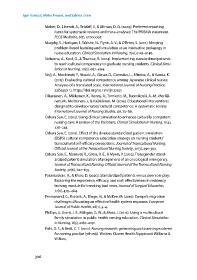Page 306 - International Perspectives on Effective Teaching and Learning in Digital Education
P. 306
Igor Karnjuš, Mirko Prosen, and Sabina Ličen
Moher, D., Liberati, A., Tetzlaff, J., & Altman, D. G. (9). Preferred reporting
items for systematic reviews and meta-analyses: The PRISMA statement.
PLOS Medicine, 6(7), e197.
Murphy, S., Hartigan, I., Walshe, N., Flynn, A. V., & O’Brien, S. (11). Merging
problem-based learning and simulation as an innovative pedagogy in
nurse education. Clinical Simulation in Nursing, 7(4), e141–e148.
Ndiwane, A., Koul, O., & Theroux, R. (14). Implementing standardized patients
to teach cultural competency to graduate nursing students. Clinical Simu-
lation in Nursing, 10(), e87–e94.
Noji, A., Mochizuki, Y., Nosaki, A., Glaser, D., Gonzales, L., Mizobe, A., & Kanda, K.
(17). Evaluating cultural competence among Japanese clinical nurses:
Analyses of a translated scale. International Journal of Nursing Practice,
23(Suppl 1). https://doi .org/1.1111/ijn.1551
Oikarainen, A., Mikkonen, K., Kenny, A., Tomietto, M., Tuomikoski, A.-M., Meriläi-
nen, M., Meittunen, J., & Kääriäinen, M. (19). Educational interventions
designed to develop nurses’ cultural competence: A systematic review.
International Journal of Nursing Studies, 98, 75–86.
Ozkara San, E. (15). Using clinical simulation to enhance culturally competent
nursing care: A review of the literature. Clinical Simulation in Nursing, 11(4),
8–43.
Ozkara San, E. (19). Effect of the diverse standardized patient simulation
(DSPS) cultural competence education strategy on nursing students’
transcultural self-efficacy perceptions. Journal of Transcultural Nursing:
Official Journal of the Transcultural Nursing Society, 30(3), 91–3.
Ozkara San, E., Maneval, R., Gross, R. E., & Myers, P. (19). Transgender stand-
ardized patient simulation: Management of an oncological emergency.
Journal of Transcultural Nursing: Official Journal of the Transcultural Nursing
Society, 30(6), 67–635.
Paramasivan, A., & Khoo, D. (). Standardized patients versus peer role play:
Exploring the experience, efficacy, and cost-effectiveness in residency
training module for breaking bad news. Journal of Surgical Education,
77(), 479–484.
Permanand, G., Krasnik, A., Kluge, H., & McKee, M. (16). Europe’s migration
challenges: Mounting an effective health system response. European
Journal of Public Health, 26(1), 3–4.
Phillips, J., Grant, J. S., Milligan, G. W., & Moss, J. (1). Using a multicultural
family simulation in public health nursing education. Clinical Simulation
in Nursing, 8(5), e187–e191.
Polit, D. F., & Beck, C. T. (1). Nursing research: generating and assessing evidence
for nursing practice (9th ed.). Wolters Kluwer Health/Lippincott Williams &
Wilkins.
36

